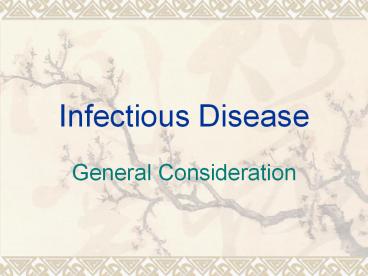Infectious Disease - PowerPoint PPT Presentation
1 / 18
Title:
Infectious Disease
Description:
Infectious Disease General Consideration Synopsis Infectious disease ( lemology, communicable disease) is: A clinical medicine A part of internal medicine To study ... – PowerPoint PPT presentation
Number of Views:937
Avg rating:3.0/5.0
Title: Infectious Disease
1
Infectious Disease
- General Consideration
2
Synopsis
- Infectious disease ( lemology, communicable
disease) is - A clinical medicine
- A part of internal medicine
- To study the regularity of the occurrence and
development of infectious disease in human body - To study etiology, pathogenesis, pathology,
clinical manifestation and the methods of
diagnosis, treatment and prevention for
infectious disease. - In order to control spread of infectious disease
in population - Infectious disease is related to biology,
immunology, parasitological, epidemiology,
pediatrics
3
Synopsis
- Infectious disease is
- A group of common disease
- Caused by different pathogens
- To possessing infectivity
- To form epidemic
- Infectious disease is a threat to the health of
people - The pathogens causing infectious diseases are
- virus, Chlamydia, rickettsia, mycoplasma,
spirochete, bacteria, fungus, protozoa and
helminthes
4
Infection and Immunity
- Definition of infection
- Complex process of interaction between pathogen
and human body - Infection is composed of three factors pathogen,
host and environment - There are commensalisms and opportunistic
infection
5
Infection and Immunity
- Manifestations of infectious process (Infection
spectrum) - Clearance of pathogen
- Covert infection (subclinical infection)
- Overt infection (Clinical infection or
apparent infection) - Carrier state
- Health carrier after covert
infection - Convalescent carrier after overt
infection - Incubatory carrier before onset of
diseases - According to carrier time acute
(transient) carrier -
chronic carrier - Latent infection
6
Infection and Immunity
- The action of pathogen in infectious process
- The pathogenicity of pathogen is related to
- Invasiveness
- virulent
- Number of pathogen
- Mutation (variability)
7
Infection and Immunity
- The action of immune reaction of host in
infectious process - Non specific immunity
- Barrier action (natural barrier)
- External barrier
- skin , mucosa
- Secretion of skin and mucosa
- Accessory organ
- Internal barrier placenta,
blood-brain barrier - Phagocytosis
- Humoral action
- Complement, Lysozyme,
Fibronection, Cytokines.
8
Infection and Immunity
- Specific immunity
- Humoral immunity
- Immunoglobulin IgG, IgM, IgE, IgA, IgD
- Cell mediated immunity
9
Epidemic process and epidemic factors of
infectious disease
- Source of infection (basic conditions)
- Patients (acute , chronic) ,Covert infection
, Carrier ,Infected animal - Route of transmission
- Contact transmission ( direct and indirect) ,
Air-borne , Food water fly borne, Insects
borne, Blood borne ,Soil borne - Susceptibility of population
- Factors of influencing epidemic process
- nature factors ,social factors
10
Features of infectious disease
- Basic features
- Pathogen
- 9 kinds of pathogen
- Infectivity
- Epidemiological features
- Quality exotic , local ,
endemicity - Quantity sporadic
occurrence, epidemic, pandemic, - outbreak,
endemicity, seasonal - Post infection immunity
- Viral infection life-long
immunity - Bacteria infection shorter
immunity - Helminthes infection no
protective immunity - Protozoa infection shorter
immunity
11
Features of infectious disease
- Clinical features
- Regularity in the development of cource
- Incubation period diagnosis , qurantine
period - Prodromal period
- Period of apparent manifestation
- Convalescent period
- Relapse
- Recrudescence
12
Common symptoms and signs
- Fever
- Three stages effervescence
- fastigium
- deffervescence
- Five kinds of fever sustained fever,
- remittent
fever, -
intermittent fever, - relapsing
fever, - saddle type
fever. - And irregular fever
13
Common symptoms and signs
- Rash eruption
- Date of eruption
- 1st chickenpox 2nd scarlet
fever - 3rd smallpox 4th measles
- 5th typhus 6thtyphoid
fever - Location of eruption
- Form of rash
- Exanthema maculo-papular rash
- Petechia
- Vesiculo-pustular
rash - Ureicaria
- Enanthema
14
Common symptoms and signs
- Toxemic symptoms
- Mononuclear phagocyte system reactions
- Hepato-splenomegale
- Lymphonodus enlarged
- Clinical types
- acute, subacute, mild, common, severe,
- fulminant, typical, atypical, abortive,
- ambulatory
15
Diagnosis of infectious diseases
- Epidemiological dates
- Clinical features
- Symptoms and signs
- Laboratory findings
- Routine examination of blood, urine, feces
- Bio-chemical examinations
- Etiological examinations
- Direct exam
- Isolation of pathogen
- Molecular biological examinations
- Immunological examinations
- Endoscope examinations
- Image examinations
16
Treatment of infectious disease
- General and supporting therapy
- Isolation of patients, rest, diet,
nursing - Pathogen or specific therapy
- Symptomatic therapy
- Rehabilitation
- Physiotherapy acupuncture
- Chinese herbs or tradition medicine
17
Prevention of infectious disease
- Management of source of infection
- 35 kinds of notifiable infectious disease
divided into 3 class - First class 2 kinds. Reported 6h
in city, 12h in country. - Second class 24 kinds. reported 12h in
city and country - Third class 9 kind
- Cut off of route
- Personal hygiene, public hygiene,
insecticide, disinfection - Protect susceptible population
- Actibe immunization
- Passive immunization
18
- 35 kinds of infectious diseases
- class one plague, cholera
- class two viral hepatitis, bacillary dysentery
and intestinal amebiasis, typhoid fever and
paratyphoid fever, AIDS, gonorrhea ,
avariosis, poliomyelitis, measles, pertussis,
diphtheria, epidemic cerebrospinal meningitis,
scarler fever, epidemic hemorrhagic fever,
rabies, leptospirosis, brucellosis,
anthrax, typhus, kala-azar, - epidemic encephalitis B, malaria,
dengue fever, - lung tuberculosis, fetal tetanus
- class threeschistosomiasis , filariasis,
hydatid disease, leprosy , influenza,
mumps, rubella, infectious dysentery,
acute hemorrhagic conjunctivitis

